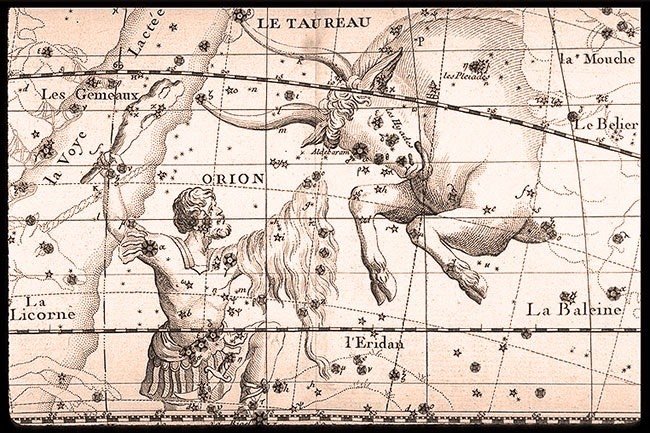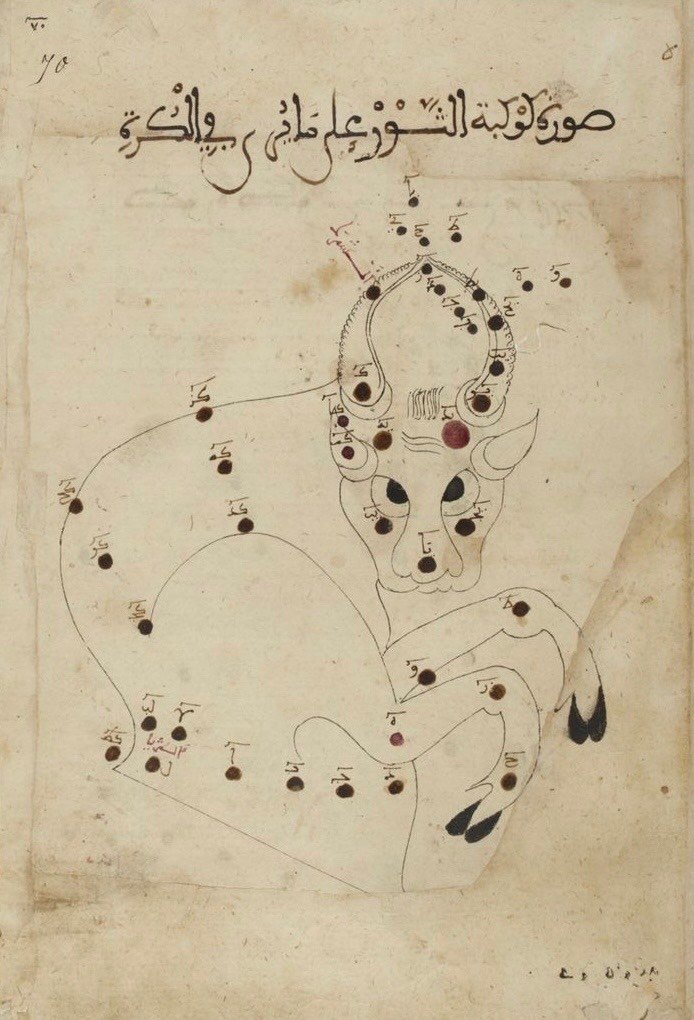Aldebaran
Aldebaran (Alpha Tauri) 10°07' tropical Gemini, 15°56' sidereal Taurus
Aldebaran (Alpha Tauri) is an orange-hued red giant marking the eye of the constellation of Taurus found at the projectd zodiacal longitude of 10°07' tropical Gemini, 15°56' sidereal Taurus. The brightest in the constellation with an apparent visual magnitude of 0.75 to 0.95, making it the fourteenth brightest star in the night sky.
Taurus & Orion in the Uranographia by Johannes Hevelius,1687
Mythos & Star Lore
Alpha Tauri has held prime significance by star seers for millennia. Thousands of years ago when this pale rose star signaled the vernal equinox, the Persians designated it as one of the four Royal Stars or Guardians of the Heavens and was known as Tascheter, the "Watcher of the East." The Akkadians referred to it as Dil-gan, the "Messenger of Light." The Babylonians saw Alpha Tauri as Ku, I-ku, or I-ku-u, the "Leading Star of Stars." The ancient Greeks called it Λαμπαδίας Lampadias, literally "torch-like or -bearer." These titles were all to signify the arrival of Spring in the northern hemisphere and the welcoming of the light following the darkness of winter.
The Arabs termed it الدبران, al Dabarān, "the Follower," which some claim is due to it following the Pleaides while others say because it once marked the second lunar station following the first. [1]
To the Seri in northwestern Mexico, Aldebaran is seen as the midwife's lamp giving light to the seven birthing mothers (Pleaides). In their lunar calendar, the month corresponding with October is called Queeto yaao, "Aldebaran's path." [2]
In some Mesoamerican cultures, particularly in North America, the Taurus constellation was seen a bison instead of a bull. The Inuit saw it as a polar bear. Aldebaran would be identified as these beasts' eye.
In Jewish, Christian and Islamic cosmology, the Four Persian Royal Stars became associated with the archangels. Thus Aldebaran is correlated with the archangel Michael, “One Who is Like God”, the chief of the archangels. Michael is the archangel of justice, triumph over evil and of healing.
Indian sky watchers view Alpha Tauri as the goddess Rohini, "the Red One," the favorite wife of Chandra (the Moon). The 4th nakshatra Rohini is marked by this star.[3]
Rohini, artist unknown, Kolkata, 1890
Lunar Mansion
Aldebaran is the principal host star in the fourth lunar mansion. In a number of ancient traditions, at one point Aldebaran marked the beginning of the calendar. Later the red star came to designate the second Lunar mansion. Now it marks the fourth.
Manzil: al Dabaran • الدبران • The Follower • The Arabs called this manzil after its host star الدبران, al Dabarān, meaning "the Follower," which some claim this is due to it following the Pleaides (al Thurayya manzil). Ghayat al-Hakim (Picatrix) says the image of Aldebaran is an armed man riding a war horse holding a snake in his right hand. Due to the Martial nature of Alpha Tauri, al-Dabaran was seen to signify enmity, struggle, conflict and chaos. Strength here is in the act of restraining violence. This manzil was also associated with victory in lawsuits and the overcoming of obstacles. Elections for this manzil were for "destruction and hindrance of buildings, fountains, wells, gold mines, the flight of creeping things and begets discord". When the Moon is transiting this manzil it is admonished to pursue business, travel, marry and take medicine. Talismanic workings were done in this manzil "for obtaining hostility" and for asking for "things pertaining to hatred, separation and evil purpose". Talismans of the star Aldebaran were prescribed for accruing wealth and good fortune, and victory in lawsuits.
Nakshatra: Rohini • रोहिणी • The Red One / Star of Ascent • Red Deer/Cow/Ox Cart/Chariot) • The symbol for this asterism is an Ox Cart or Chariot, which represents material progress. It is also associated with the Red Deer. The deity abiding here is Prajapati, the creator-god Brahma, who represents higher consciousness. It is ruled by Chandra (Moon), and its indicator star is Alpha Tauri (Aldebaran). In the Indian tradition, Aldebaran or Rohini is also known as the "Star of Ascent," helping to elevate its natives to positions of power and confers a sensual passionate nature which may lead to an overly materialistic hunger. When well-balanced, Rohini finds spirituality grounded in the material or earthly realm. It is considered a stable asterism favorable for coronations, expiatory ceremonies, planting and sowing, building of towns and matters of a permanent nature when containing the Moon.
Xiù: Bì • 毕宿 • Net • The symbol for this lodge is a Net. The asterism consists of ε Tauri, δ3 Tauri, δ1 Tauri, γ Tauri, Aldebaran, θ2 Tauri, 71 Tauri and λ Tauri. The lodge is named after ε Tauri 畢宿 一 Bì Xiù yī, which translates to "the First Star of Net". Its planetary lord is the Moon. Bì is the 5th lunar lodge in the White Tiger of the West (西方白虎; Xīfāng Báihǔ), one of the Four Symbols of the Chinese constellations that mark the seasons and directions and contain the 28 Lunar Lodges. White Tiger of the West represents the West and Autumn.
Astrological Magic
“The Bull will dower the countryside with honest farmers and will come as a source of toil into their peaceful lives; it will bestow, not gifts of glory, but the fruits of the earth. It bows its neck amid the stars and of itself demands a yoke for its shoulders. When it carries the sun’s orb on its horns, it bids battle with the soil begin and rouses the fallow land to its former cultivation, itself leading the work, for it neither pauses in the furrows nor relaxes its breast in the dust. The sign of the Bull has produced a Serranus and a Curius, has carried the rods of office through the fields, and has left its plough to become a dictator [eque suo dictator venit aratro]. Its sons have the love of unsung excellence: their hearts and bodies derive strength from a massiveness that is slow to move, whilst in their faces dwells the boy-god Love (Cupido)."
—Manilius[6]
The Bodlein MS states that Aldebaran with the Moon conjunct the Ascendant or Midheaven increases riches and brings great honors.[7]
Aldebaran is said to grant honor, intelligence, eloquence, steadfastness, integrity, popularity, courage, ferocity, a tendency to sedition, a responsible position, public honors and gain of power and wealth through others, but its benefits seldom prove lasting and there is also danger of violence and sickness.[4]
Talismans of Aldebaran are prescribed for accruing wealth, good fortune and victory in battles (this includes lawsuits).[7]
“Under Aldebaran they made images according to the likeness of God or a flying man: it gathered wealth and honor.”
Aldebaran sigil as per Agrippa
Plants & Gemstones
Aldebaran has sympathy with the plant Milk Thistle (Silybum marianum) and the gemstones Ruby & Garnet
Candles & Incense
Red candles, Dragon's Blood or Copal resin are to be used when invoking Aldebaran
Silybum marianum
“I wasn’t chosen to be first. I was just chosen to command that flight. Circumstance put me in that particular role. That wasn’t planned by anyone.”
—
References:
[1] Richard Hinckley Allen, Star Names, Their Lore and Meaning
[2] Mary B. Moser; Stephen A. Marlett, COMCÁAC QUIH YAZA QUIH HANT IHÍIP HAC
[3] Kenneth Johnson, Mansions of the Moon, The Lost Zodiac of the Goddess
[4] Vivian Robson, The Fixed Stars & Constellations in Astrology
[5] The Complete Picatrix, translated by John Michael Greer & Christopher Warnock
[6] Manilius, Astronomica
[7] Christopher Warnock, Fixed Star, Sign & Constellation Magic
[8] Heinrich Cornelius Agrippa, Three Books of Occult Philosophy, Book II





